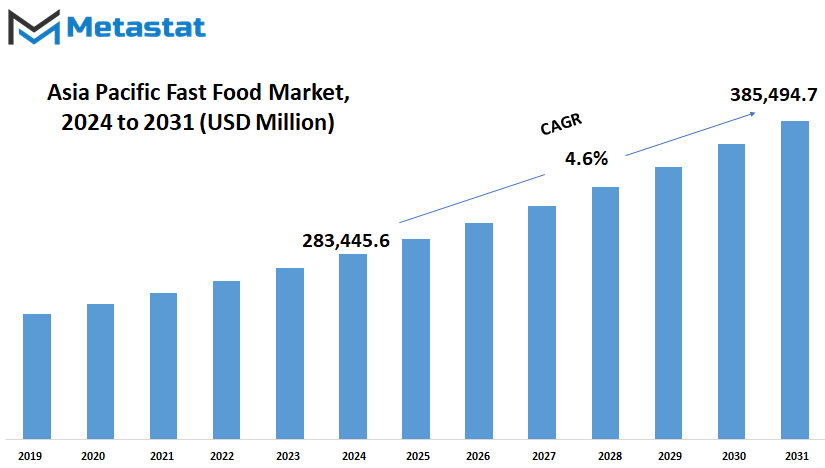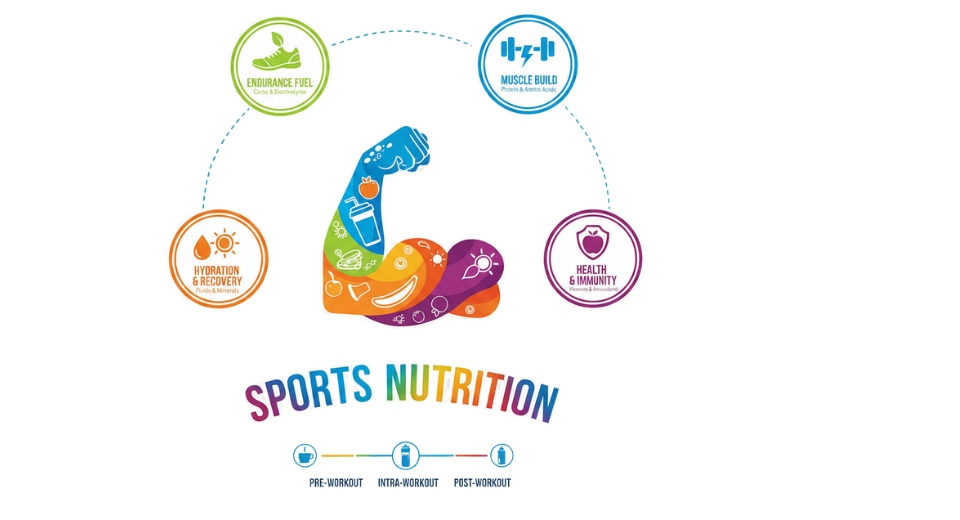MARKET OVERVIEW
The Asia Pacific fast food market is a dynamic and vibrant sector within the broader food industry, characterized by a diverse array of culinary offerings that cater to the tastes and preferences of consumers across the region. This market encompasses a wide range of establishments, from globally recognized chains to local eateries, each competing to capture a share of the ever-expanding consumer base.
In recent years, the Asia Pacific fast food industry has witnessed significant transformation, driven by shifting consumer lifestyles, urbanization, and changing dietary habits. The region's rapid economic growth has led to an increase in disposable incomes, fueling the demand for convenient and affordable dining options. As a result, fast food outlets have proliferated across urban centers, offering a variety of cuisines ranging from traditional favorites to innovative fusion creations.
One of the defining characteristics of the Asia Pacific fast food market is its rich culinary diversity. From the spicy street food stalls of Bangkok to the sushi counters of Tokyo, the region boasts a plethora of flavors and cooking styles that reflect its cultural heritage and gastronomic traditions. This diversity is further enhanced by the influence of Western fast food chains, which have adapted their menus to suit local tastes while retaining their core brand identity.
Moreover, technological advancements have revolutionized the way fast food is consumed and delivered in the Asia Pacific region. The rise of online food delivery platforms and mobile ordering apps has made it easier than ever for consumers to access their favorite fast food offerings with a few taps on their smartphones. This has not only expanded the reach of fast food chains but has also heightened competition within the industry, as players vie for supremacy in the digital marketplace.
Despite these advancements, the Asia Pacific fast food market is not without its challenges. Concerns over health and nutrition have prompted consumers to seek out healthier alternatives, leading some fast food chains to introduce lighter options and emphasize the use of fresh, locally sourced ingredients. Additionally, the COVID-19 pandemic has presented unprecedented challenges to the industry, forcing many establishments to adapt to new safety protocols and navigate fluctuating consumer demand.
Looking ahead, the Asia Pacific fast food market is poised for continued growth and innovation as operators strive to meet the evolving needs of discerning consumers. Whether it's through menu diversification, digital innovation, or sustainability initiatives, the industry remains committed to delivering convenient and satisfying dining experiences that resonate with the diverse tastes of consumers across the region.
The Asia Pacific fast food market is a dynamic and multifaceted industry that reflects the rich culinary tapestry of the region. From traditional street food vendors to global fast food chains, the sector continues to evolve in response to changing consumer preferences and market dynamics. As competition intensifies and innovation drives growth, the future of the Asia Pacific fast food market promises to be as exciting as it is delicious.
Asia Pacific Fast Food market is estimated to reach $385,494.7 Million by 2031; growing at a CAGR of 4.6% from 2024 to 2031.

GROWTH FACTORS
The Asia Pacific fast food market has been witnessing notable growth, primarily fueled by factors such as busy lifestyles and increasing urbanization. These aspects drive the demand for convenient dining options, making fast food a popular choice among consumers with limited time for meal preparation. Additionally, the rapid urbanization of densely populated areas contributes to the proliferation of fast food outlets, as they cater to the needs of busy city dwellers.
However, alongside these growth drivers, the market also faces challenges that could potentially impede its expansion. One such challenge is the rising concerns about the health impacts associated with the consumption of fast food. As awareness about health and wellness grows, consumers are becoming more cautious about their dietary choices, leading to a shift towards healthier eating habits.
Furthermore, the fast food market encounters competition from alternative food options that offer healthier and more diverse choices. As consumers become more health-conscious, they are increasingly inclined to explore alternatives to traditional fast food, such as organic options, plant-based meals, and freshly prepared dishes.
Despite these challenges, the market presents promising opportunities for growth through innovation and adaptation. One such opportunity lies in the innovation of menu offerings and ingredients to align with changing consumer preferences for healthier and more sustainable fast food options. By introducing healthier ingredients, such as lean proteins, whole grains, and fresh produce, fast food chains can appeal to health-conscious consumers while retaining the convenience and affordability that characterize the fast food industry.
Moreover, catering to evolving consumer preferences for sustainability can also drive growth in the fast food market. This involves adopting eco-friendly practices, such as using biodegradable packaging, sourcing locally grown ingredients, and reducing food waste. By embracing sustainability initiatives, fast food companies can not only attract environmentally conscious consumers but also contribute to the overall well-being of the planet.
While the Asia Pacific fast food market faces challenges such as health concerns and competition from alternative food options, it also presents significant opportunities for growth through innovation and adaptation. By addressing consumer preferences for healthier and more sustainable choices, fast food companies can position themselves for success in an increasingly health-conscious and environmentally aware market landscape.
MARKET SEGMENTATION
By Type
The fast food industry in the Asia Pacific region is a dynamic and diverse market that caters to a wide range of consumer preferences. Within this market, there are various types of fast food offerings, each appealing to different tastes and dietary needs. One way to categorize these offerings is by type, which helps to understand the variety and scope of the industry.
The Asia Pacific fast food market, when categorized by type, encompasses a range of products designed to meet the needs of consumers looking for convenient and quick meal options. These types include instant breakfast/cereals, instant soups and snacks, ready meals, baked goods, meat products, and other product types.
Instant breakfast/cereals are popular choices for consumers seeking quick and easy morning meals. These products often include items such as cereal bars, instant oatmeal, and breakfast pastries, providing a convenient option for those with busy lifestyles or limited time in the mornings.
Similarly, instant soups and snacks offer consumers a convenient way to satisfy their hunger cravings throughout the day. These products typically include items such as instant noodles, packaged snacks, and soup cups, providing a quick and satisfying option for on-the-go consumers.
Ready meals are another segment of the Asia Pacific fast food market, offering pre-packaged meals that can be easily heated and consumed. These meals come in a variety of flavors and cuisines, catering to different tastes and dietary preferences.
Baked goods are a popular choice for consumers looking for quick and tasty snacks or desserts. These products include items such as pastries, bread, and cakes, providing a convenient option for those looking for a sweet treat or a quick snack.
Meat products are also an important segment of the Asia Pacific fast food market, with offerings such as burgers, sandwiches, and fried chicken being popular choices among consumers. These products provide a convenient and satisfying option for those looking for a hearty and filling meal.
In addition to these main types, the Asia Pacific fast food market also includes other product types that cater to specific dietary needs or preferences. These may include vegetarian or vegan options, gluten-free products, or specialty items catering to specific cultural tastes or traditions.
Overall, the Asia Pacific fast food market offers a diverse range of products catering to the needs and preferences of consumers across the region. By categorizing these products by type, it becomes easier to understand the variety and scope of the industry, highlighting the diverse range of options available to consumers seeking convenient and quick meal solutions.

By Distribution Channel
The Asia Pacific fast food market is a dynamic landscape with various distribution channels catering to consumer preferences. These channels include Quick Service Restaurants (QSRs), Food Service Restaurants (FSRs), and Online Food Delivery platforms.
Quick Service Restaurants, commonly known as fast-food chains, are a prevalent distribution channel in the Asia Pacific region. These establishments focus on providing convenient and quick meals to customers on the go. With a wide array of menu options, QSRs attract a diverse customer base, ranging from busy professionals seeking a quick lunch to families looking for a convenient dining option.
Food Service Restaurants represent another significant segment in the Asia Pacific fast food market. Unlike QSRs, FSRs offer a more extensive menu selection and often provide a sit-down dining experience. These restaurants cater to consumers looking for a more relaxed atmosphere to enjoy their meals. FSRs may include casual dining restaurants, themed eateries, and upscale dining establishments, each offering its unique ambiance and cuisine choices.
In recent years, the emergence of Online Food Delivery platforms has revolutionized the fast food market in the Asia Pacific region. These platforms enable consumers to order food from their favorite restaurants and have it delivered directly to their doorstep. With the growing popularity of online ordering and delivery services, many fast-food chains and independent restaurants have partnered with these platforms to expand their reach and tap into the burgeoning online consumer market.
The division of the Asia Pacific fast food market by distribution channel reflects the diverse preferences and lifestyles of consumers in the region. While some individuals prefer the speed and convenience of QSRs, others may opt for the more extensive menu options and dining experience offered by FSRs. Additionally, the rise of online food delivery has provided consumers with even more choices and convenience, further shaping the landscape of the fast food industry.
Overall, the Asia Pacific fast food market continues to evolve, driven by changing consumer preferences and advancements in technology. With a range of distribution channels available, from traditional brick-and-mortar establishments to online platforms, consumers have more choices than ever before when it comes to satisfying their cravings for fast food. As the market continues to grow and adapt to new trends, businesses within the industry must remain agile and innovative to stay competitive and meet the demands of today's discerning consumers.
REGIONAL ANALYSIS
The Asia-Pacific fast food market presents a diverse landscape, with key players vying for dominance across various countries in the region. It encompasses nations such as India, China, Japan, South Korea, and the Rest of Asia-Pacific, each offering its unique set of opportunities and challenges.
India stands out as a significant market within the region, characterized by a burgeoning population with a growing appetite for convenience and international cuisines. The rapid urbanization and changing lifestyles in urban centers fuel the demand for fast food, making it a lucrative space for both local and international fast food chains. Moreover, the presence of a vast young population, inclined towards trying new food experiences, further propels the growth of the fast food industry in India.
China, with its colossal population and a thriving urban middle class, represents a colossal market for fast food giants. The country's rapid economic growth has led to a shift in dietary preferences, with an increasing inclination towards quick and convenient dining options. Domestic players like KFC and McDonald's have successfully tapped into this demand, adapting their offerings to suit the local palate while maintaining their global appeal.
Japan boasts a mature fast food market, characterized by a strong culture of convenience and efficiency. Here, fast food chains have innovated to cater to the discerning tastes of consumers, offering a blend of traditional Japanese flavors with international favorites. Moreover, the rise of health-conscious consumers has prompted fast food brands to introduce healthier alternatives, such as low-calorie options and organic ingredients, to their menus.
South Korea presents a dynamic market for fast food, driven by its tech-savvy population and a penchant for culinary experimentation. The country's vibrant food culture, influenced by both local traditions and global trends, provides ample opportunities for fast food chains to introduce innovative menu items and engage with discerning consumers. Additionally, the prevalence of food delivery services and online platforms has further expanded the reach of fast food brands, making it convenient for consumers to indulge in their favorite meals anytime, anywhere.
The Rest of Asia-Pacific encompasses a diverse range of markets, each with its unique socio-cultural dynamics and consumer preferences. From Southeast Asian nations like Thailand and Indonesia to emerging markets like Vietnam and the Philippines, the region offers immense potential for fast food players willing to navigate the complexities and adapt their strategies accordingly.
The Asia-Pacific fast food market presents a mosaic of opportunities and challenges across its various segments, with India, China, Japan, South Korea, and the Rest of Asia-Pacific serving as key battlegrounds for fast food brands aiming to capture market share and establish a strong foothold in the region.
COMPETITIVE PLAYERS
The Asia Pacific Fast Food market is a dynamic landscape with various companies vying for consumer attention and market share. Among the prominent players in this industry are Ajisen Ramen, Burger King, Dicos, Subway, HokBen, Dominos, Ippudo, Isaac Toast, Jollibee, KFC, Khaan Buuz, Lotteria, McDonald’s, Mom’s Touch, Wendy’s, Pepper Lunch, Starbucks, Taco Bell, Tai Hing, Gongcha, HeyTea, Shakey's Pizza Asia Ventures, Inc., Mr. Lee's Foods, and Tasty Congee & Noodle Wantun Shop, Maxim's Caterers.
These companies engage in fierce competition, employing various strategies to attract customers and stay ahead in the market. Ajisen Ramen, known for its flavorful ramen dishes, competes with Burger King, which offers a range of burgers and fast-food options. Dicos, another significant player, specializes in fried chicken and sides, catering to consumers' preferences for crispy delights. Subway, with its focus on fresh and customizable sandwiches, stands in competition with HokBen, a popular Indonesian chain offering a diverse menu of rice and noodle dishes.
In addition to these players, Dominos and Ippudo bring their unique offerings to the table. Dominos is renowned for its pizza delivery service, appealing to those craving cheesy indulgence, while Ippudo specializes in authentic Japanese ramen, targeting consumers with a taste for traditional flavors. Isaac Toast, a rising star in the industry, offers a variety of toasted sandwiches, competing with established giants like Jollibee, known for its Filipino-style fast food offerings.
Furthermore, KFC, Lotteria, and McDonald’s have a significant presence in the market, each offering its signature fried chicken, burgers, and fries, respectively. Mom’s Touch, Wendy’s, and Pepper Lunch also contribute to the competitive landscape with their unique menu items and marketing strategies. Starbucks, Taco Bell, and Tai Hing cater to consumers seeking coffee, Mexican cuisine, and Chinese dishes, respectively, adding diversity to the market.
Moreover, Gongcha, HeyTea, and Shakey's Pizza Asia Ventures, Inc. offer refreshing beverages, trendy tea options, and classic pizza choices, appealing to different consumer preferences. Mr. Lee's Foods and Tasty Congee & Noodle Wantun Shop provide delicious Chinese cuisine, while Maxim's Caterers offers a wide range of dining options to meet diverse tastes.
Overall, the Asia Pacific Fast Food market is characterized by intense competition among a diverse range of players, each striving to innovate and capture the hearts and palates of consumers across the region. With such a dynamic landscape, companies continue to evolve their strategies to stay relevant and maintain their competitive edge in this thriving industry.
Fast Food Market Key Segments:
By Type
- Instant Breakfast/Cereals
- Instant Soups and Snacks
- Ready Meals
- Baked Goods
- Meat Products
- Other Product Types
By Distribution Channel
- Quick Service Restaurants
- Food Service Restaurants
- Online Food Delivery
Key Asia Pacific Fast Food Industry Players
- Ajisen Ramen
- Burger King
- Dicos
- Subway
- HokBen
- Dominos
- Ippudo
- Isaac Toast
- Jollibee
- KFC
- Khaan Buuz
- Lotteria
- McDonald’s
- Mom’s Touch
- Wendy’s
WHAT REPORT PROVIDES
- Full in-depth analysis of the parent Industry
- Important changes in market and its dynamics
- Segmentation details of the market
- Former, on-going, and projected market analysis in terms of volume and value
- Assessment of niche industry developments
- Market share analysis
- Key strategies of major players
- Emerging segments and regional growth potential








 US: +1 3023308252
US: +1 3023308252






